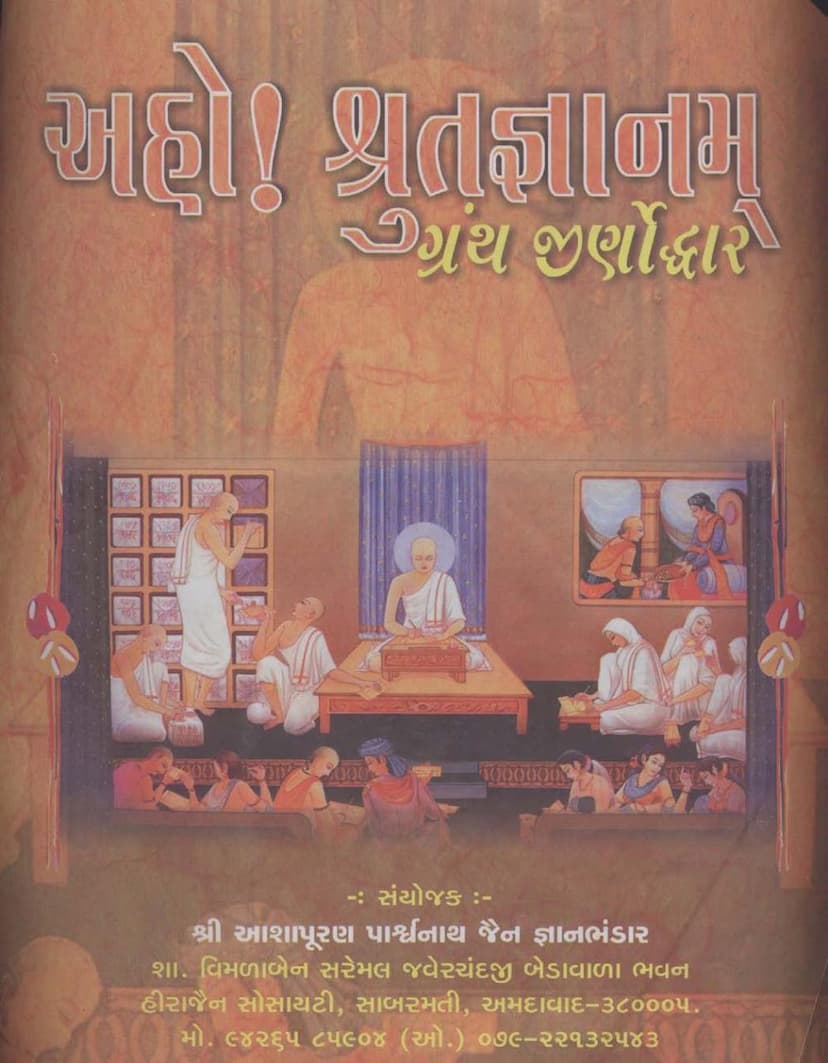Jain Lekh Sangraha Part 3
Added to library: September 2, 2025

Summary
Here's a comprehensive summary of the provided Jain text, "Jain Lekh Sangraha Part 3" by Puranchand Nahar, based on the provided pages:
Title: Jain Lekh Sangraha Part 3 (जैन लेख संग्रह भाग-३) Author: Puranchand Nahar Publisher: Puranchand Nahar
Overall Purpose and Context:
This document is the third part of a collection of Jain inscriptions (Lekh Sangraha) compiled by Puranchand Nahar. It is part of a larger initiative called "Aho Shrut Gyanam Granth Jirnyauddhar" (अहो श्रुतज्ञानम् ग्रंथ जीर्णोद्धार), which aims to preserve and make accessible important, often rare or endangered, Jain texts. The project involves scanning, digitizing, and reprinting these valuable works.
Key Information from the Pages:
- Preservation Initiative: The text clearly indicates a project dedicated to the "Jirnauddhar" (restoration/preservation) of Jain texts. This initiative is driven by a deep reverence for Jain scriptures ("Shrut Gyanam").
- Sponsorship and Support: The project is supported by various individuals and institutions. Notably, Shri Ashapuran Parshwanath Jain Gyanbhandar (शा. विमळाबेन सरेमल जवेरचन्दजी बेडावाला भवन) in Ahmedabad is mentioned as the coordinator for Set No. 1 and Set No. 2, and likely Set No. 3 as well. Pujya Sadhvi Shri Jayvantashriji M.S. and her community are credited with providing inspiration and support. Donations from Surat are also acknowledged.
- Catalogue of Works: The core of the provided pages consists of a detailed list of Jain books that are part of the "Aho Shrut Gyanam Granth Jirnauddhar" project. These books span various subjects within Jainism and related fields, including:
- Siddhanta Texts: Nandi Sutra, Uttaradhyayan Sutra, Nandi Sutra Avachuri, etc.
- Philosophy and Logic: Yukti Prakash Sutra, Manatunga Shastra, Nyayapravesa, Anekant Jayapataka, Syadvadh Ratnakar, etc.
- Architecture and Sculpture (Shilpa Shastra): Vastuvidya, Shilpa Ratna, Prasad Tilak, Kashyap Shilpa, Rajavallabha, etc. These are particularly prominent, with many titles dedicated to temple architecture (Prasad Mandan, Prasad Tilak).
- Astrology and Divination: Jyotirmahoday, Janasamuudrajatak, Jain Samudrik.
- Lexicography and Grammar: Abhidhan Rajendra, Shabdarathakosh.
- Poetry and Literature: Tilakamanjari, Saptasaptati Mahakavyam, etc.
- History and Culture: Bharatiya Jain Shraman Sanskriti aur Lekhanakala, Bharat ke Jain Tirthon.
- Miscellaneous: Jain Stotra Sanchaya, Ayurvedic texts, etc.
- Volume III Focus (Jaisalmer Inscriptions): While the initial pages list a broad range of works, the later pages (starting from the Foreword in English and the extensive introduction in Hindi) specifically detail the contents of "Jain Inscriptions" Part III by P. C. Nahar. This volume focuses on inscriptions collected from Jaisalmer and its surrounding areas (Lodrava, Amarsagar, Devikote).
- Significance of Jaisalmer: Jaisalmer is highlighted as a place of immense importance for Jain history and antiquity, containing vast Jain Bhandars (libraries) with ancient manuscripts. The presence of numerous ancient temples and inscriptions makes it a crucial site for research.
- New Inscriptions: The Foreword by P. C. Nahar states that the third volume contains 479 inscriptions, of which 458 are new, building upon previously published inscriptions. This underscores the significant contribution of this work to the field.
- Specific Highlights of Jaisalmer Inscriptions: Nahar draws attention to several unique and interesting inscriptions:
- Tapapattika Inscription (No. 2144): This inscription details austerities and penances mentioned in Jain Agamas along with the dates of the five "Kalyanaks" (significant life events) of Tirthankaras.
- Prasasti of Parshwanath Temple at Lodrava: This unique Prasasti is written in verse within a "Satadala Padma Yantra" (hundred-petalled lotus diagram).
- Pattawali (Page 177): An inscription enumerating a lineage of Jain Acharyas from Lord Mahavira to Devardhi Gani Kshamashramana.
- Architectural and Sculptural Appreciation: Nahar notes the architectural excellence of Jaisalmer's monuments, mentioning the beautiful carvings on the Parshwanath temple porch and the magnificent dome of the Shantinath temple, appreciating their proportion and artistry.
- Historical Context: The text includes a detailed historical account of Jaisalmer, its rulers (the Bhati dynasty), and the origins of the Oswal community. It references historical sources like Colonel Tod and local chronicles.
- Linguistic and Technical Aspects: The summary indicates an interest in the technical and artistic achievements in inscriptions, such as the "Satadala Padma Yantra" and the intricate lettering.
- Contribution to Scholarship: The compilation aims to provide invaluable material for scholars and enthusiasts of Jain history, epigraphy, and art.
In essence, "Jain Lekh Sangraha Part 3" is a monumental work by Puranchand Nahar, presenting a vast collection of Jain inscriptions from Jaisalmer and its environs. It is a crucial component of a broader effort to preserve Jain heritage, providing scholars with essential primary source material for understanding Jain history, philosophy, art, and culture.